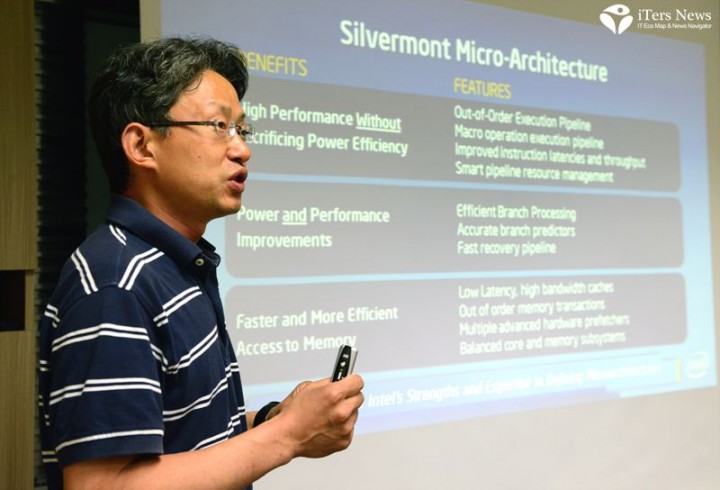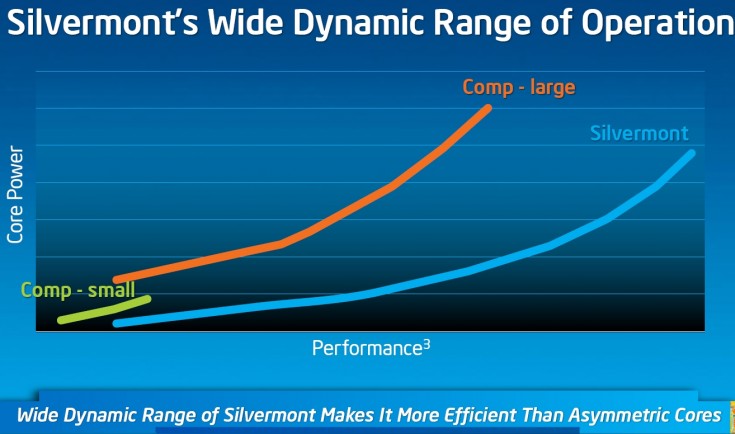(iTers News) -Coming loaded with a flood of multimedia features like 3D graphics and H.264 full-HD codec, today’s smartphones are running on as powerful a CPU as PCs of a couple a years ago did.
That bodes well for the future of Intel, who has been struggling to make a huge dent in ARM Holding’s stronghold in mobile processor architecture market, but with little success so far. The multimedia-heavy applications are where Intel’s processor architecture technology prevailed, because its long instruction sets outdo rival ARM’s relatively short instruction words in the multimedia performance.
Smartphones are where power savings still matters as much as multimedia features, however. When it comes to power consumption, ARM is still an undisputed winner. To make up for their respective drawbacks, both of the two rivals are joining the next race to better optimize the multimedia performance and the power budget than the other.
(Intel Korea President HS Lee)
Multiple tasks with one instruction
ARM came to the fore, unveiling so-called ARM big. Little SOC architecture that enables SoC chip makers to integrate a low-power processor and a high performance into a single silicon die -32-bit Cortex-A7/A15 or 64-bit Cortex-A53/A57.
Intel set out to fight back with a new line of 64-bit Atom architecture codenamed as Silvermont. Fabricated with Intel‘s 22nm FinFET 3D transistor technology, the 64-bit dual core Silvermont is made up of tons of tri-gate 3D transistors. Unlike traditional planar transistors, the tri-gate transistor is structured in a 3 dimension, occupying less space o silicon footprint. That space savings allowed Intel to cram more of transistors into a single silicon die to better manage and control multimedia-heavy graphics functionalities and power consumption. The 3D tri-gate transistor structure also helps the chip maker to dramatically reduce heat dissipation, eventually leading to significant cuts in the power consumption.
True enough, the Silvermont architecture is nothing short on the PC processor architecture like Intel’s legacy Westmere in performance, incorporating many variations of its legacy processor circuitry like a new out-of-order execution engine, a macro-operation execution pipeline, and a new multi-core and system fabric architecture.
But, it consumes 5 times less power than its predecessor Atom architecture for the same performance, implementing a new set of power management architectures like intelligent burst technology and low power C-state.
(Intel Korea technical marketing manage Dr.Choi)
“The 22nm FinFET processor technology was a key enabler for cramming more of innovative functionalities in the Silvermont architecture, because the process technology enables us to shrink the size of a transistor and thus pack more of them into a single silicon die,” said HS Lee, president with Intel Korea, Ltd.
22nm FinFET; More transistors, less power
For example, Intel has implemented a legacy out-of-execution engine, which allows the CPU core to execute instruction 2, while waiting for instruction 1 in order. The out-of-order execution is nothing new, but it requires other logic circuitry like branch prediction to exactly and efficiently implement the engine. “The ramp-up to the 22nm process technology enabled us to embed the out-of-order engine and other peripheral circuitry into the silicone architecture,” explained Dr. Jin UK, Choi, technical marketing manager, Korea Application Design Center with Intel.
In addition, Intel has incorporated a new system fabric architecture that can well manage communications between cores and memory sub-system to allow multiple cores to efficiently share data resources among them without contending for faster access to the bus interface. The new system interface technology helps reduce data latency. For example, Intel implemented a new interconnect architecture called as dedicated point-to-point interface or IDI.
To address growing demand for workload-heavy multimedia feature like 3D game and full HD image rendering, Intel has implemented its legacy SSE instruction sets, too but optimized them for use in mobile applications without sacrificing power budget.
As smart phone display screens are getting as large as 5-inches and 6-inches, consumers’ demand for multimedia features are growing. Yet, our competitor’s instruction sets are relatively so short that they can’t well perform multimedia features. We have successfully optimized the long SSE instruction set for mobile application. This implementation for mobile applications was really new breakthrough trial,“ said Dr Choi with Intel.
Dynamic power management
Another innovation is its implementation of the legacy virtualization technology for mobile applications, which allows the architecture to run on multiple OS systems from Android to Windows. The macro-operation execution is a technology that allows the CPU core to execute multiple jobs with one instruction, fetching data from memory cell, decoding, executing and brining back to store. The branch prediction is a technology about predicting what to come as next instruction.
Intel’s innovation doesn't’t stop there. To cut back power consumption, Intel incorporates a wider dynamic operation range technology that allows a CPU core to operate in a wide range of frequency from 200MHz to 2.5GHz depending on workloads. The technology is in sharp contrast with Nvidia’s low voltage power saving core that uses low voltage to perform light workload. Unlike Qualcomm’s asynchronous CPU architecture that switch back and for the between low and high voltage cores depending on workloads, the dynamic frequency range doesn’t need to route between them.
Its burst mode technology also allows the architecture to cut power consumption by well managing peak performances of each core depending on tasks. The architecture has a modular architecture so that it can scale up to incorporate up to 8 cores. Its power management operation is so dynamic that it can quickly wake -up from sleep, or standby mode
All combined, it consumes 5 times less power than the Atom for the same performance, and performs three times better at the same power consumption. The Silvermont is the first refreshed architecture to be re-fabricated with 14nm.
It is also a cross-market platform to address a wide range of applications from smart phones to tablet PCs to Ultrabooks to PCs to data center servers.
Photos and Videos by JH Bae




